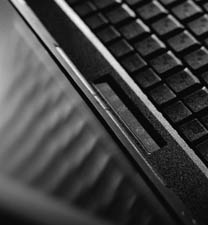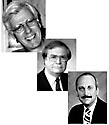|
 Previous Page Previous Page
Laptop Litigation:
The impact of technology on litigation
 However, there
are many evils that can result from the use of this software
and the related hardware that neither courts nor the bar have
begun to address in any meaningful way. Many of these evils will
be the subject of a future article, but it is important to at
least catalog some of the more serious dangers. However, there
are many evils that can result from the use of this software
and the related hardware that neither courts nor the bar have
begun to address in any meaningful way. Many of these evils will
be the subject of a future article, but it is important to at
least catalog some of the more serious dangers.
The use of this type of software and related hardware can
seriously disadvantage an opponent who is not equally well equipped.
Of greater concern, electronic litigation support software, and
other powerful commercial software and related image manipulation
software, can be used to distort or manipulate evidence in ways
that have been unthinkable in the past. For example, someone
could use a digital camera to capture an accident scene or some
other important event. When this digital image is imported into
the computer, there is no negative or other way to trace how
this photograph was created. Using powerful software such as
Adobe's
Photoshop 5.0, subtle but material changes could be made
to the photograph and a witness then could testify that the photograph
indeed represents what he or she saw at a particular time or
place. How does one cope with such dishonesty, or determine that
such a deception has even occurred?
Software such as TrialDirector® also can be used to pretreat
evidence or actually manipulate evidence while it is being presented
in court. For instance, an attorney calls up a piece of evidence
via a color projector and then has a witness mark or manipulate
the evidence in some fashion, by using a light pen, for example.
In fact, a new version of an exhibit may thus have been created.
However, as soon as the lawyer kills the electronic presentation,
that new evidence disappears. Rules need to be crafted that will
enable an adversary and a court to capture such evidence and
ensure its inclusion in the record.
|

Michael McChrystal, top, Marquette 1975, is
a professor of law at the Marquette University Law School.
William Gleisner, middle, Marquette 1974,
both a practicing attorney and computer consultant, maintains
a law firm-based litigation support service bureau in Milwaukee.
Michael Kuborn, bottom, Marquette 1998, is
with Olsen, Kloet, Gundersen & Conway, and is trained in
computer recovery and computer search and seizure techniques.
Products and services mentioned in this article should not be
construed as an endorsement.
|
Several other changes to existing rules of court also should
be considered. To avoid surprise, counsel should be required
to produce more than just copies of evidence they plan to present
at trial. They should be required to provide technical information
about how the exhibits will be presented. Then an opportunity
should be provided to both opposing counsel and the court to
view the images and other electronic evidence in advance of trial
to determine if there is anything objectionable about the technical
aspects of a presentation before it is published to a jury.
Courts should consider adopting special rules that address
online evidence, such as mandating the means and methods of ensuring
that the court and all counsel can verify that online evidence
corresponds to original sources. Indeed, the entire matter of
evidentiary authentication needs to be rethought. What about
evidence that never was intended to have a hardcopy counterpart?
Is it time to consider a standard that cannot be defeated, comparable
to an electronic signature, so that certain forms of sensitive
electronic data (for example, online contracts, confirming email,
digitally created photographs) can be authoritatively authenticated
when they are offered into evidence? At present, we are just
beginning to see the first stirrings of interest in such matters
in Wisconsin.29
We can be certain that the information age will bring many
new often radically new innovations, but we cannot
possibly predict what those innovations will be. However, litigation
must always involve a search for the truth. The rules of evidence,
since the days of Wigmore and before, have always concerned themselves
with ensuring that the trier of fact will have the benefit of
the best and most authentic evidence, and the rules of civil
procedure have always had as their goal the orderly providing
of that evidence to the trier of fact in as fair a manner as
possible. Serious thought needs to be given to the creation of
rules that will be flexible enough to encompass whatever new
developments are thrust upon us in the exploding information
age. A comprehensive study of our rules of civil procedure and
evidence needs to be done with the care that has attended such
well-thought-out undertakings as the Uniform Commercial Code
or the Restatements of law.
Conclusion
The rules of the game may be changing, but it's still litigation,
and the search for truth remains the goal. Nevertheless, there
is a real danger that the litigation process will become a victim
of technical innovation. The rules that control this new world
must be designed to remove the magic and ensure that litigation
continues to focus on justice and not just electronic pyrotechnics.
Later articles in this series will focus on specific methods
of coping with the challenges that are presented when attorneys
employ electronic litigation techniques. The next article will
discuss what objections and challenges can be made when opposing
counsel introduces electronic evidence, and what changes in court
rules should be adopted in order to respond to the challenges
of electronic litigation.
Endnotes
1ABA/BNA Lawyers' Manual of Professional
Conduct, Current Reports, 11 LMPC 3, d10 at p. 5 of Westlaw online
version (1996).
2 See, for example,http://www.cyberlaw.com;
http://legalonline.com,
and our own State Bar's http://www.wisbar.org, to name only a
few of the superior and inexpensive legal resources now on the
Internet.
3See, e.g., Massey v. Prince
George's County, 918 F. Supp. 905 (D. Md. 1996), wherein
the court observed:
"The Court turns to Respondents' further answer to its
Show Cause Order, namely that the Assistant County Attorney who
filed the Motion for Summary Judgment in this case did not know
about the Kopf case. That, of course, may well be true,
but the question is, ought he to have known? . [C]ounsel had
an obligation to provide 'competent representation,' which includes
an ability to research the law. Case reports are available in
hard cover and online from computers. The Natural Language search
method on Westlaw [in the appropriate database] reveals that
the two most frequently referenced cases are (1) Kopf v. Skyrm,
9933 F.2d 374 (4th Cir. 1993), which is the appeal after remand
of Kopf v. Wing, 942 F.2d 265 (4th Cir. 1991), and (2)
Kopf v. Wing itself." Id., at 908.
Consider also the probable use as a standard of the following
excerpt from The Competitive Impact Statement of the U.S. Department
of Justice, appended to the Consent Decree in U.S. v. Thomson
Corp., at *23, 1997 WL 226233 (D. D.C. 1997):
"Print versions of the law are not adequate substitutes
for comprehensive online legal research services. Legal researchers
who have the necessary computer hardware and the necessary skills
to use this product value the timeliness and speed of comprehensive
online legal research services. Material provided on a comprehensive
online legal research service is updated often and is thus more
timely than material offered in printed form. Full-text word
searching of primary law on CD-ROMs is not an adequate substitute
for comprehensive online legal research services. The content
of most CD-ROMs is limited to a particular jurisdiction or topic.
Moreover, the material contained on CD-ROMs is not as current
as the material offered on an online legal research service.
If the materials on CD-ROMs are not current, lawyers must still
use online legal research services to supplement their research.
Furthermore, the topical or limited jurisdictional focus of CD-ROMs
limits their primary appeal to smaller law firms or firms specializing
in a particular area of the law. These firms are not heavy users
of comprehensive online legal research services. While the Internet
is a useful tool for some researchers, it is not a substitute
for Lexis-Nexis and Westlaw for several reasons. First, the material
contained on the Internet is not nearly as comprehensive as the
material offered on Lexis and Westlaw. The Internet does not
provide access to historical opinions, every court's opinions,
every jurisdiction's statutes, or the number of secondary law
products that Lexis-Nexis and Westlaw offer. Second, the Internet's
search mechanism is not as sophisticated or effective as Lexis-Nexis'
or Westlaw's. Third, the case law offered on the Internet does
not provide citations that are accepted by courts or are relied
on by attorneys." Id. at *23.
4Wells & Winger, Now in
Development: The Courthouse on the Web, 12 Legal Tech Newsl.
1 (March 1998) ("Under prototype programs in a handful of
federal courts, Web sites are now beginning to assume some of
the key functions of the courthouse. Parties can file and serve
motions and other papers electronically, and judges, clerks,
lawyers and their staffs can view them via the Internet.");
see also Kruger, Electronic Filing of Claims and other
Pleadings in the Southern District of New York, 767 PLI/Comm
291 (April 1998).
5R. Timothy Muth, Old Doctrines
on a New Frontier: Defamation and Jurisdiction in Cyperspace,
68 Wis. Law. 10 (Sept. 1995).
6McChrystal, Gleisner, and Kuborn,
Document
Destruction and Confidentiality, 71 Wis. Law. 24 (Aug.
1998) ("Lawyers and clients should know that data they've
entrusted to a computer system may have a much longer life and
be harder to erase than merely executing a 'delete' command".)
7McChrystal, Gleisner, and Kuborn,
Law Enforcement
in Cyberspace: Search and Seizure Law Applied to Computer Data,
71 Wis. Law. 35 (Dec. 1998).
8See ABA Formal Ethics Opinion
95-398 ("A lawyer who gives a computer maintenance company
access to information in client files must make reasonable efforts
to ensure that the company has in place, or will establish, reasonable
procedures to protect the confidentiality of client information.
Should a significant breach of confidentiality occur, the lawyer
may be obligated to disclose it to the client.")
9Berman, Practical Issues in
Framing and Responding to Discovery Requests for Electronic Information,
ABA Center for Continuing Legal Education National Institute
(Oct. 22-23, 1998). See also Grenig, Electronic Discovery:
Making Your Opponent's Computer a Vital Part of Your Legal Team,
21 Am. J. Trial Advoc. 293 (1997); Shear, Electronic Evidence:
It's Not "Cutting Edge" Anymore, 21 Lawyer's PC
1 (1994); Lehman, Litigating in Cyberspace: Discovery of Electronic
Information, 8 S.C. Law. (1997); Olmsted, Electronic Media:
Management and Litigation Issues When "Delete" Doesn't
Mean Delete, 63 Def. Couns. J. 523 (1996).
10Ginhart, Paperless Federal
Litigation, 45 Fed. Law. 42, 44 (May 1998).
11Hansen, Courts Saving Time
and Trees, 85 A.B.A. J. 20 (March 1999).
12See the court's Web page at
http://www.fjc.gov/.
13A good example is the court's
Web page in the MDL 926 Breast Implant Litigation. See,
http://www.fjc.gov/BREIMLIT/mdl926.htm
14Yoshinaga, Is Electronic
Court Filing in Your Future?, 10 Utah B. J. 15 (1997).
15See http://www.courts.state.wi.us/WCS.
16See
http://www.wiw.uscourts.gov.
17Id.
18Id., at http://www.wiw.uscourts.gov/pub_district/electronic_courtroom/default.htm.
19Solano, Electronic Briefs:
Soon to be Commonplace, 19 Penn. Law. 18 (1997).
20Doar Litigation Services has
developed some innovative and advanced technical services since
the days of the simple Doar Projector. See http://www.doar.com.
21See Concordance's home page
at http://www.dataflight.com.
22http://www.jfsnet.com.
23http://www.gravitynet.com.
24http://www.isysdev.com.
25http://www.inmagic.com.
26Id.
27http://summation.com.
28http://indatacorp.com.
29See, e.g., Muth &
Bell, Wisconsin's
Voyage to Computerized Courts, 71 Wis. Law. 14 (Feb.
1998); Jensen, Laws
in the Making: AB811 Regulates the Use of Digital Signatures
in Wisconsin, 71 Wis. Law. 23 (April 1998); cf.,
Johnson, Computer Printouts as Evidence: Stricter Foundation
or Presumption of Reliability? 75 Marq. 439 (1992).
|
